How to remove dust from the air can sometimes be challenging. Dust is one of the common triggers of asthma and allergies.
In addition to being an eyesore, it affects your health adversely, causing you many respiratory issues.
For people with already existing asthma and allergies, dust can trigger an attack or further exacerbates their condition.
In addition, microscopic dust particles bind to the nasal passages and lungs and initiate a malfunction of your respiratory system.
Although, it’s impossible to remove dust from your home permanently. However, reducing its amount in your home is very doable. This post provides tips to kick dust out of your home.
What is dust?
Contrary to popular belief, dust is not just minerals from the soil. Instead, it combines…
Fabrics, hairs, dead skin cells, mould spores, dander, cockroaches and insect poops, and the decomposed remains of insects.
All of these components bind together electrostatically. This isn’t a science fiction article.
But dust comprises electrostatic charges, which gives it a magnetic ability to attract tiny dust particles with opposite directions flying around.
What causes a lot of dust in a house?
A large percentage of the dust that enters your house starts at the doorstep.
Dust gets trapped beneath shoes and on the surfaces of clothes and accompanies people when they enter your home.
In fact, according to some research, 60% of the dust in the house gets in with people through your doorway.
Dust also finds its way into your house when you leave your windows open for too long.
And that’s not all…
When you leave cracks and cervices unsealed in your house, this provides openings for the dust to come into your home and for insects to reproduce and create all sorts of dust.
These accumulate tons of dust trapped on surfaces, under the rugs, carpets and in various hard-to-reach places.
Once in your home, it settles on various surfaces. And if left untreated, it adversely affects your air quality and, subsequently, your health.
As an asthmatic or allergy sufferer, you want to reduce the rugs and carpets in your home. If possible, USE ONLY TILES.
You’d be shocked at how significantly your indoor air quality will improve.
Why does my house get so dusty so fast?

Low humidity and high humidity play an essential role in the amount of dust you have in your house.
The moisture levels in your home at low humidity drop, consequently leading to dryness.
This dryness causes a buildup of electrostatic charges, creating a magnetic effect, which attracts a whole bunch of dirt and dust into your home.
As you humidify your house to reduce dust, you don’t want too much moisture…
Because high humidity leads to a drastic increase in your home’s moisture levels, creating the perfect condition for moulds and dust mites to grow and thrive in your home.
And this ultimately leads to dust buildup.
Does a humidifier help with dust?
As stated above, humidity greatly helps limit the dust in your house. So in your quest to get rid of dust in your home, you must ensure your humidity indoors is always within the recommended threshold.
And that’s 30 to 50%.
Moulds, mildew, and, most significantly, dust mites, which are dust-creating agents, thrive when the indoor humidity exceeds 60%.
Therefore, you should endeavour to keep your humidity at optimal levels.
Getting a humidifier and dehumidifier installed in your home should be in your master plan; if you could get a humidifier-dehumidifier combo, great!
As far as achieving optimal humidity levels is concerned, they do the job. Click here to learn about the effect of humidifiers on asthma.
How do you know if your house is too dusty?
- When you start to see dust in hard-to-reach places, it indicates that you have lots of dust and your home is due for a cleaning.
- Also, when your house is too dusty, the odour of your home changes and becomes terrible. Because of the accumulation of dust, dirt, moulds, dander, and unwanted debris, your room becomes stuffy and musty. It’s an obvious sign that your house needs a thorough cleaning.
- Additionally, when your asthma and allergies flare up frequently, and you fall sick more often than expected, the symptoms improve when you go out. Unfortunately, it’s probably your home making you sick because of too much dust.
- How often do you check your filters? You should check your filters at least once in 3 months. A filter that frequently accumulates dust signifies your home has much dust. You may have to change your filter if it isn’t reusable.
How to clean and remove dust from the air in the home
Now, let’s get to the crux of the matter. Removing dust in your home can be easy if you approach it correctly.
First, you need to start with your doorway. Ensure you have two door mats at the entrance of your home.
- Use door mats.
These mats serve as a barrier and trap the dust underneath your shoes that gets into your house.
Here’s the trick, use two door mats at every entrance point.
Put one door mat by the door, outside the premises, and the second mat inside the premises when you open the door.
- Use Blinds For Your Windows
Another effective way of removing dust in your home is by replacing all your curtains with blinds. Have you ever flapped your curtains or the ones at somebody’s house?
The dust flies everywhere and settles on the surfaces around it. It’s because curtains collect tons of dust.
So, never use curtains. Instead, use blinds. Blinds are easy to clean.
- Cut Down on The Decor.
In addition, you want to use less decor in your home. As much as decor can be nice and gives your home a cosy look and feel, it collects dust, making cleaning surfaces harder.
By cutting down on decor, you’ll make cleaning much more manageable. And most importantly, it reduces the amount of dust in your house.
- Always eat at the table
We often overlook it…But when you drop food particles on the floor, they may attract insects.
As a result, you would have food debris and insect parts in your home, which decay and eventually become dust.
How to remove dust from high areas
To ensure your cleaning is effective, you must do it like a professional. And experts use the right tools and techniques. And you’re about to learn that.
Now let’s dive into it.
First thing first, whenever you clean, always begin with HIGH DUSTING. This is because when we clean, we pay more attention to the areas we can see…
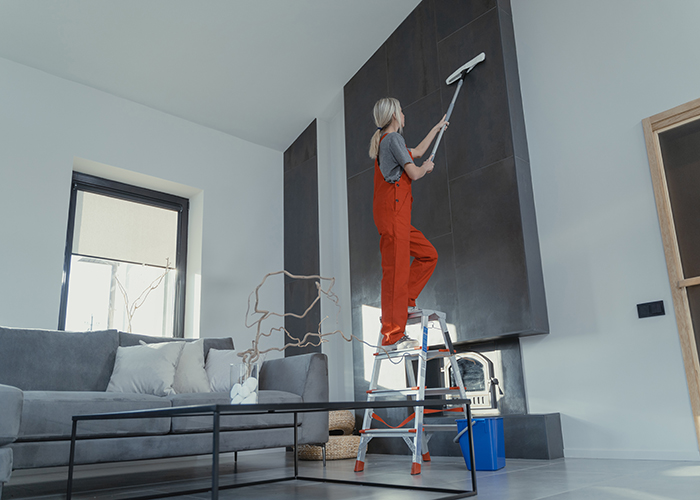
We focus on areas at our eye level and downwards, while the stuff high up is what we tend to clean the least— Such as the top of your doorways, windows, ceiling fans, crown mouldings, light fixtures, cabinet and more.
For efficient cleaning, you want to work with gravity. So dust the highest points in your room, including your walls, from top to bottom.
Now, the dust from the high places settles on the surfaces and floors. So that should be your next cleaning target.
How to clean dust from surfaces
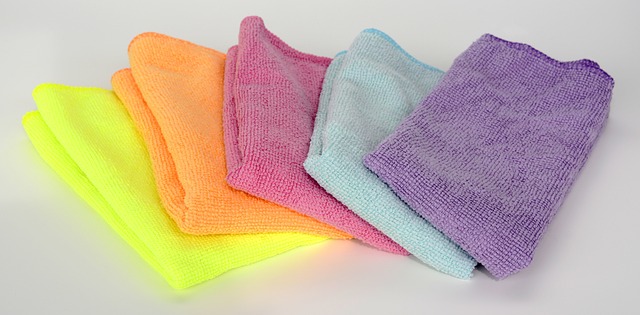
- Always use a damp microfiber.
To clean surfaces effectively, experts recommend using a general-purpose MICROFIBER TOWEL…
Because a microfiber cloth has tiny fibres that pick up an electrostatic charge, making dust magnetic toward the fabric—making your cleaning much more straightforward.
A handy trick to effective cleaning is the 8-Sided trick. First, you fold the microfiber cloth into quarters.
One microfiber cloth gives eight cleaning surfaces. You aren’t being gross. Professional cleaners use this trick, as you can get a lot of mileage with just one fabric.
- Minimise using of a feather duster to remove surface dust.
Feather dusters have minimal application. However, they help remove cobwebs and clean areas you don’t want to disturb.
If you must use a feather duster, a great technique is to move it from one side to the other in quick strokes.
Then once you’re through, bring the feather near the floor, and tap it off so the dust drops on the floor.
Then you can use it again.
But, this may not be as effective as using a microfiber cloth. A feather duster, during dusting, tends to move dust around.
- Clean Electronics with Anti-static Spray
Next, you need to clean the surface of your electronics. When it comes to dust, electronics are usually the primary target.
Plastic comprises electrostatic charges, so they attract dust like a magnet.
Use a microfiber towel dampened with an ANTI-STATIC SPRAY to clean your electronics.

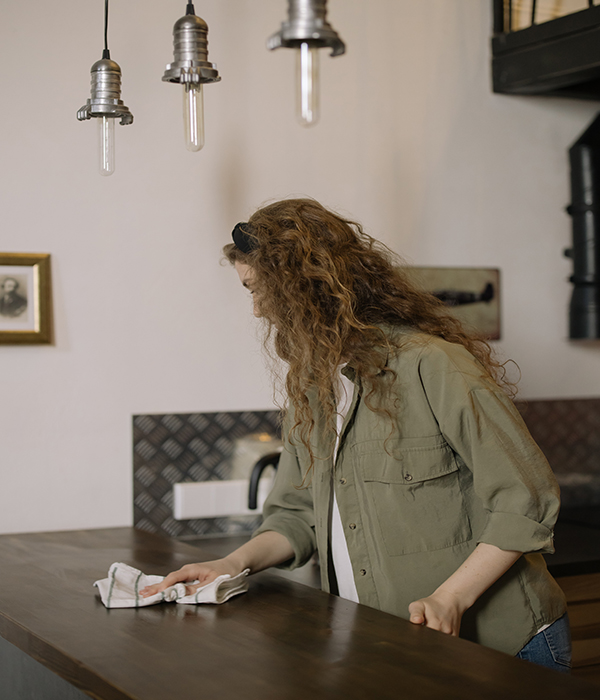
Anti-static spray removes static charges and reduces the amount of dust on the surfaces.
Now that you’ve cleaned the high areas and surfaces, the dust particles will be littered all over the floor.
So it would be best if you now focused on cleaning the floor.
How to clean dust from your floors
- Remove carpets.
Once more, one needs to point out that carpets and rugs are the most prominent dust collectors…
Therefore, to eliminate dust, you should get rid of your carpets.
Also, dust mite infestation can lead to more dust accumulation. Removing dust mites will go a long way in limiting dust in your home.
- Use a vacuum cleaner with a HEPA filter.
Vacuuming is one of the best ways of removing dirt and dust from your floor. Fortunately, vacuuming is very effective than sweeping.
Sweeping tends to kick part of the dust back into the surroundings. So, you can use a vacuum cleaner. Some people can get by vacuuming just once a week.
But…
If you have pets, you’re asthmatic, or you’re a person with allergies, you must regularly clean to avoid piling up dust in your home.
Use a vacuum with a built-in HEPA (high-efficiency particulate air) filter.
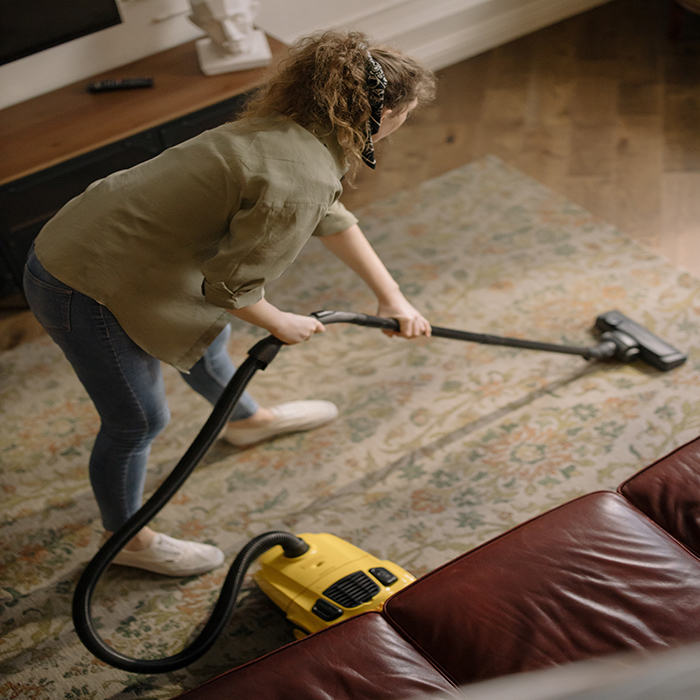
A HEPA filter works by forcing contaminated air through a fine mesh. The filter traps all the dust comprising pollen, hairs, dander, dust mites, and even tobacco smoke.
- Mop the floors.
There needs to be more than vacuuming alone cos some pathogens and dust remain on the floor even after cleaning.
So, please mop the floor. In mopping the floors, use a non-toxic cleaner. It keeps the air fresh.
Experts recommend using warm water with a small quantity of soap or vinegar.
As an asthmatic, you don’t have to worry about the vinegar smell affecting you because it evaporates quickly.
How to remove dust from the air in the bedroom
When cleaning your bedroom from dust particles, please use the above approach by starting with high dusting.
Wiping down all surfaces from top to bottom. Then, using a vacuum cleaner with HEPA filter to clean the floor.
- Decluttering.
It doesn’t matter the nature of the clothes you have inside. All textiles collect dust.
The wardrobe is a huge dust collector, so you want to keep your wardrobe as neat and organised as possible.
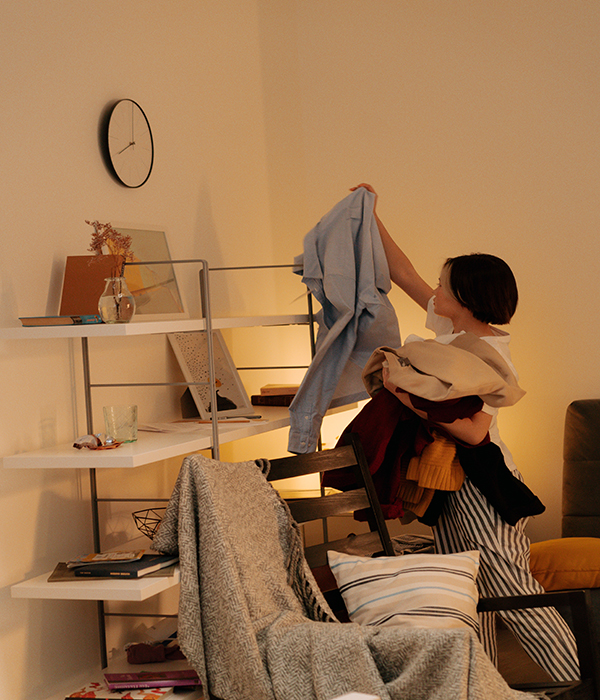
Therefore, remove all your off-season clothes from your shelves and drawers and store them temporarily in plastic containers. And discard all unwanted items.
- Could you replace your bedding regularly?
Your bedding accumulates sweat and dead body cells. And consequently leads to dust.
So change your bedding and towels once a week, and Put all rubbish out!
Here’s a vital tip: Don’t make your bed immediately when you wake up. There’s always some moisture on the bed when you sleep.
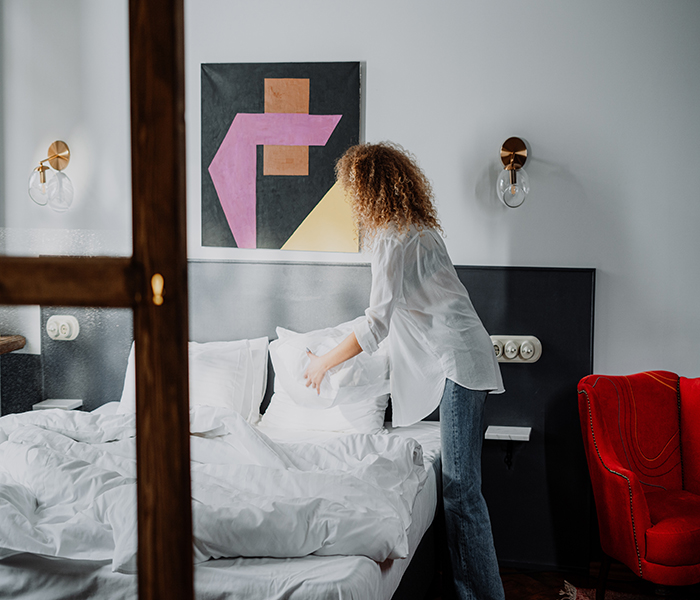
Covering this warm moisture allows bacteria and dust to grow.
Therefore…
Open your windows for at least 5 minutes to let out the dusty air and allow some fresh air.
However, please DON’T open it for too long; dust might enter your room.
How to clean and disinfect your mattress Video
Here is a free tutorial by Carl from “Cleaning How To“. He teaches you the best way to clean and sanitise your mattress yourself without the help of a professional.
Your mattress absorbs about 200 mils of your sweat each night. Also, you shed a lot of skin cells yearly.
When dust mites feed on this stuff, they grow, reproduce and deposit all faecal matter. All of these accumulate and lead to tons of dust inside your mattress.
Trust me; you want to take advantage of this. It’s epic!
At this point, you’d need to clean and sanitise your mattress. Else, breathing and sleeping become a huge problem.
You should clean and disinfect your mattress once in three months.
What is the fastest way to get dust out of the air?
The fastest and best way to remove dust from the air is through an Air Purifier with HEPA filters…
An Air Purifier with a True HEPA filter is excellent for dust particles as small as 0.3 microns in size with an efficiency of 99.97%.
Unfortunately, 0.3 micron-sized particles are quickly drawn into the lungs, negatively impacting your breathing.
A True HEPA Air Purifier technology has a dense filter that traps dangerous dust particles.
Air Purifiers with True HEPA filters also help to eliminate airborne dust mites and their droppings in your home. Click here to learn about how air purifiers help with dust mites.
Irrespective of how efficient and thorough you are at cleaning your home, it’s always essential to have an air purifier to capture little specs of dust or dirt that missed your vacuum and mop. For Asthmatics and allergy sufferers, it’s a must-have.
The Nuwave Oxypure Air Purifier comes with a True HEPA filter and two robust sensors, and it uses a 5-stage filtration technology to eliminate every bit of dust in the air.
Plus, it’s ozone-free. You need this device to maintain clean air in your home. You can learn more about the product here.
The Best 15 Cleaning Hacks
- Use door mats; One by the door outside, the other inside the premises
- Nobody should wear shoes inside anymore.
- Don’t use curtains. Use blinds instead.
- Humidify the air.
- Use a damp micro microfiber cloth for dusting.
- Use Anti-static spray to clean the surface of the electronics
- Use less decor.
- Remove unnecessary items from your home.
- Remove and store all your off-season clothes in plastic containers.
- Use a vacuum with a built-in HEPA filter.
- Mop your floors with warm water and vinegar.
- Change your bedding and towels weekly.
- Eat at the table.
- Vacuum and disinfect all surfaces, rugs and door mats.
- Properly maintain and clean your dusting gadgets.
Frequently Asked Questions
Do air purifiers get rid of dust?
Air Purifiers with a True HEPA filter are powerful and efficient at removing dust in your home.
They capture particles as little as 0.3 microns in size. So if you’re battling with how to remove dust from the air, an air purifier comes in handy.
Do ceiling fans create more dust?
A dirty ceiling fan can create and deposit dust all over your home. If your home is dusty, it can further the messy state of your home by spreading dust around. So, your fans should always be clean.
Does vacuuming create more dust?
A poorly maintained or malfunctioning tends to increase dust. Your vacuum should always be clean if your vacuum has a cleanable filter.
When using the vacuum, you should check the back to be sure it’s properly sealed.
You want to ensure the air from the back of the vacuum isn’t blowing out dust behind you.
What will repel dust?
Both anti-static spray and microfiber cloth repel dust. When applied on surfaces during cleaning, an anti-static spray creates a magnetic effect that repels dust away.
Similarly, a microfiber towel has tiny fibres that use charges to pull dirt away, making your cleaning job effortless.